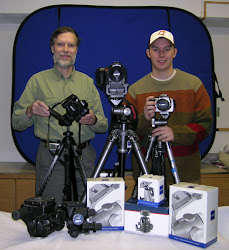Like many people who've made the switch from film cameras to digital, I've discovered that the lens tools I once used so effectively on my cameras to soften, diffuse and vignette my images for quality "finished" professional results won't do for digital what they did for film.
I'm sure it's arguable by some that their diffusers still work fine, and I too have discovered that some tools still work okay under some circumstances; my Ziess Softar #1 seemed to offer decent results when photographing a single subject in the studio but I knew that the black netting diffuser that I used with my Lindahl Bell-o-shade no longer worked on the Nikon D70 zoom lens at the wider angles without showing lines in the image. Not a risk I was willing to take professionally so I just stopped using the Lindahl shade and drop-down filters for a while.
Then it happened. A savvy carriage trade-minded customer brought in a wall portrait that she had purchased several years ago by a photographer obviously using medium format lens tools like I was used to using in the past with my film camera. She wanted her new wall portraits to have that same "softened" look. So I arrived at the portrait session armed with my digital camera equipped with the very mild Softar Filter that works at any aperture on any lens thinking that this was good insurance at getting the kind of "softness" she could live with.
Understand that I knew any diffusion used on an entire family group portrait would be more exaggerated by their relative head sizes but I had explained that to her and she assured me she liked her portrait images "very soft".
While the images looked good on the small camera monitor, once I opened them up in Photoshop and printed them out as proofs I knew they were too soft. I called a colleague who is a digital expert and explained to him what I had done. He told me that you simply cannot use on-lens filters anymore for professional softening and diffusion without creating mush on 35mm type digital camera images. This leaves the special effects job now to the computer and not the camera. "But I've tried using Photoshop CS for their diffusion tools and what I get doesn't look like real photography," I complained, "The results are terrible." He agreed that Photoshop's filters weren't the right tools either to mimic the professional photography filters of the past but told me that there is a company that has a software program that is a plug-in for my Photoshop and has filter tools to recreate believable results for various levels of softening and diffusion.
The software is called "PhotoKit" and is available from Pixel Genius for only $49.95. I bought the Mac version and it is wonderful. I have played around with it now and have found that you can get varying degrees of whatever you want that looks similar to what you used to be able to do with your old lens filters and drop-down tools. Even more possibilities are now available to you. One of my favorites is the ability to lasso areas and "clear" the results of diffusion keeping eyes and teeth sparkly and sharp.
If there is a downside to doing your diffusion this way it's that the customer can't really see the results on the proof, so they have to "trust" your artistic license. But it was like this with retouching too so there will be a short new education curve for your clientele to learn, or to save yourself from disaster you might offer a second proof appointment to show the customer a proof of their selected images with the added softening or diffusion. It's going to take more time and you'll end up with having to rework some things more than you want so I'd only recommend this for customers like mine who's initial concern was the diffusion issue.
In summary, softening and diffusion can be done effectively and professionally but it's not as easy as it used to be when you'd just pick the filter you wanted and pop it over the lens. Your old on-camera lens filters will often turn your digital images to "mush" or images of weak contrast that may or may not be salvageable.
Tom Ray is a Certified Professional Photographer through the Professional Photographers of America. If you are interested in his full story please go to: Professional Photography: Success Without School
Visit : Cheap Handbags4u







0 comments:
Post a Comment